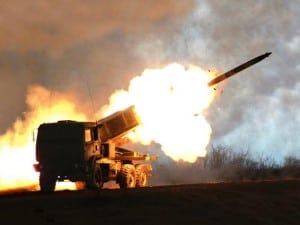The Army’s top acquisition official on Monday cited Guided Multiple Launch Rocket Systems (GMLRS), Patriot missiles and High Mobility Artillery Rocket System (HIMARS) launchers as munitions programs that could “potentially” benefit from the ability to use multi-year contracts for procurement.
As Congress considers a potential provision allowing the use of multi-year contracts to buy large quantities of critical munitions, Doug Bush, the Army’s assistant secretary for acquisition, logistics and technology, told reporters he believes such an authority could be helpful for weapons the Army is building in “large scale already where we have hot production lines.”

Photo: Lockheed Martin
“A great advantage of multi-year contracts is you usually save a lot of money. You stabilize the industrial base and you stabilize suppliers because there’s hopefully a four- or five-year contract for something versus one year at a time, where you get more variance. The downside of multi-years are you don’t have quite as much flexibility year-to-year. But there are many benefits,” Bush said during a media roundtable.
Bill LaPlante, the Pentagon’s top acquisition official, said earlier this month he believes Congress will approve a provision allowing the department to award multi-year contracts for munitions procurements, which he has cited as an option to ensure supply chain stability in the future as the department looks to refill its inventories of what’s been supplied in larger numbers to Ukraine (Defense Daily, Nov. 7).
“We’re going to have multi-year authority. I believe in the Congress. They are supportive of this. They’re going to give us multi-year authority and they’re going to give us funding to really put into the industrial base, and I’m talking billions of dollars into the industrial base, and to fund these production lines,” LaPlante said during a discussion at an event hosted by George Mason University and the Defense Acquisition University.
Bush said he didn’t want to presume Congress will approve such a provision and noted that such an authority for multi-year contracts wouldn’t apply to all Army weapons programs but “could have great benefits” for producing capability such a GMLRS, Patriot missiles and “perhaps even a launcher platform like a HIMARS.”
“My experience over the years has been that if the department presents a good argument to Congress, they’ve often been supportive of multi-year approaches as long as the numbers add up. So I think we’ll have to prove that in each individual case here to where the value of doing the multi-year is demonstrable in terms of cost savings and production stability,” Bush said. “That would be, for the Army, unusual, but this could be the circumstance where it’s a good idea. But we’re still working on it.”
In September, LaPlante reiterated his goal remains to replenish inventories of equipment sent to Ukraine on a ‘one-to-one’ basis, either with current systems or next-generation updates (Defense Daily, Sept. 7).
The Army announced last week it recently awarded $520.8 million in contract options to Lockheed Martin [LMT] for GMLRS production to help replenish stockpiles of the weapon sent to Ukraine (Defense Daily, Nov. 14).
In early October, the Army also awarded Lockheed Martin a $14.4 million production contract for HIMARS to help replenish stockpiles of the launcher system (Defense Daily, Nov. 17).
Bush told reporters he was “overall very pleased” with the pace of the process for awarding contracts related to weapons being provided to assist Ukraine.
“Some are concerned that we’re going too slow on some of these contract awards. I can just tell you that we are using every authority we have to do this as rapidly as possible,” Bush said. “The government still has to collect information, usually from industry, to determine that a price is fair and reasonable. So sometimes that results in a little bit of delay from industry having to collect the data we need to make those judgments.”